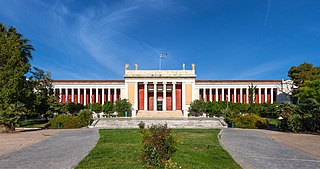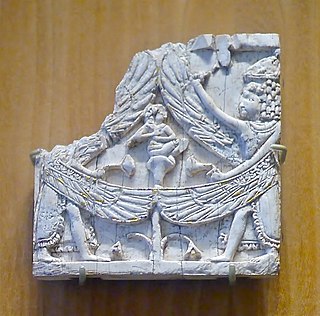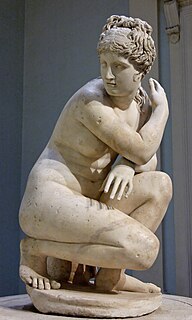Related Research Articles

The Louvre, or the Louvre Museum, is the world's most-visited museum, and a historic landmark in Paris, France. It is the home of some of the best-known works of art, including the Mona Lisa and the Venus de Milo. A central landmark of the city, it is located on the Right Bank of the Seine in the city's 1st arrondissement. At any given point in time, approximately 38,000 objects from prehistory to the 21st century are being exhibited over an area of 72,735 square meters. Attendance in 2021 was 2.8 million due to the COVID-19 pandemic, up five percent from 2020, but far below pre-COVID attendance. Nonetheless, the Louvre still topped the list of most-visited art museums in the world in 2021.

The University of Pennsylvania Museum of Archaeology and Anthropology—commonly known as the Penn Museum—is an archaeology and anthropology museum associated with the University of Pennsylvania. It is located on Penn's campus in the University City neighborhood of Philadelphia, at the intersection of 33rd and South Streets. Housing over 1.3 million artifacts, the museum features one of the most comprehensive collections of middle and near-eastern art in the world.

The J. Paul Getty Museum, commonly referred to as the Getty, is an art museum in Los Angeles, California housed on two campuses: the Getty Center and Getty Villa.

The National Archaeological Museum of Naples is an important Italian archaeological museum, particularly for ancient Roman remains. Its collection includes works from Greek, Roman and Renaissance times, and especially Roman artifacts from the nearby Pompeii, Stabiae and Herculaneum sites. From 1816 to 1861 it was known as Real Museo Borbonico.

The National Archaeological Museum in Athens houses some of the most important artifacts from a variety of archaeological locations around Greece from prehistory to late antiquity. It is considered one of the greatest museums in the world and contains the richest collection of Greek Antiquity artifacts worldwide. It is situated in the Exarcheia area in central Athens between Epirus Street, Bouboulinas Street and Tositsas Street while its entrance is on the Patission Street adjacent to the historical building of the Athens Polytechnic university.

The Getty Villa is at the easterly end of the Malibu coast in the Pacific Palisades neighborhood of Los Angeles, California, United States. One of two campuses of the J. Paul Getty Museum, the Getty Villa is an educational center and museum dedicated to the study of the arts and cultures of ancient Greece, Rome, and Etruria. The collection has 44,000 Greek, Roman, and Etruscan antiquities dating from 6,500 BC to 400 AD, including the Lansdowne Heracles and the Victorious Youth. The UCLA/Getty Master's Program in Archaeological and Ethnographic Conservation is housed on this campus.

The Istanbul Archaeology Museums are a group of three archaeological museums located in the Eminönü quarter of Istanbul, Turkey, near Gülhane Park and Topkapı Palace.

Arslan Tash, ancient Hadātu, is an archaeological site in Aleppo Governorate in northern Syria, around 30 kilometres (19 mi) east of Carchemish and the Euphrates and nearby the town of Kobanî.

Looted art has been a consequence of looting during war, natural disaster and riot for centuries. Looting of art, archaeology and other cultural property may be an opportunistic criminal act or may be a more organized case of unlawful or unethical pillage by the victor of a conflict. The term "looted art" reflects bias, and whether particular art has been taken legally or illegally is often the subject of conflicting laws and subjective interpretations of governments and people; use of the term "looted art" in reference to a particular art object implies that the art was taken illegally.

The Crouching Venus is a Hellenistic model of Venus surprised at her bath. Venus crouches with her right knee close to the ground, turns her head to the right and, in most versions, reaches her right arm over to her left shoulder to cover her breasts. To judge by the number of copies that have been excavated on Roman sites in Italy and France, this variant on Venus seems to have been popular.
Marion True was the former curator of antiquities for the J. Paul Getty Museum in Los Angeles, California. True was indicted on April 1, 2005 by an Italian court, on criminal charges accusing her of participating in a conspiracy that laundered stolen artifacts through private collections and creating a fake paper trail; the Greeks later followed suit. The trial brought to light many questions about museum administration, repatriation, and ethics.

The History Museum of Armenia is a museum in Armenia with departments of Archaeology, Numismatics, Ethnography, Modern History and Restoration. It has a national collection of 400,000 objects and was founded in 1920. 35% of the main collection is made up of archaeology related items, 8% of the collection is made up of Ethnography related items, Numismatics related items make up 45%, and 12% of the collection is made up of documents. It is regarded as Armenia's national museum and is located on Republic Square in Yerevan. The state financially supports the museum and owns both the collection and the building. The museum carries out conservation and restoration work and publishes works on Armenian architecture, archaeology, ethnography, and history. They also have published a series of reports on archaeological excavations since 1948. The museum carries out educational and scientific programs on Armenian history and culture as well.
The MACM, the Mougins Museum of Classical Art is an art museum located in the village of Mougins, in the Alpes-Maritimes department, France. It is 30 minutes from Nice airport and 15 minutes from the centre of Cannes.

The Le Antichità di Ercolano Esposte is an eight-volume book of engravings of the findings from excavating the ruins of Herculaneum in the Kingdom of Naples. It was published between 1757 and 1792, and copies were given to selected recipients across Europe. Despite the title, the Antichità di Ercolano shows objects from all the excavations the Bourbons undertook around the Gulf of Naples. These include Pompeii, Stabiae, and two sites in Herculaneum: Resina and Portici.
Grant Frame is a Canadian-American Assyriologist, Professor Emeritus of the University of Pennsylvania, and Curator Emeritus of the Babylonian Section of the University of Pennsylvania Museum of Archaeology and Anthropology. He is an expert on Akkadian language and literature and on the history and culture of ancient Mesopotamia in the first millennium BCE, in particular the Neo-Assyrian and Neo-Babylonian periods. Since 2008, he has served as Director and Editor-in-Chief of The Royal Inscriptions of the Neo-Assyrian Period (RINAP), an international research project funded by the U.S. government's National Endowment for the Humanities and other granting agencies, to translate the royal inscriptions of the rulers of Assyria from 744 to 609 BC. The RINAP project marks the continuation of the Royal Inscriptions of Mesopotamia (RIM) project, which Frame's teacher and mentor, Albert Kirk Grayson, founded at the University of Toronto in 1978 and led until his retirement with support from the Social Sciences and Humanities Research Council of Canada.
References
- ↑ "Catalogue of the Museo Archeologico di Napoli (Inventory MANN) - Wikimedia Commons".
- ↑ "Collection Highlights: Antiquity". State Hermitage Museum. Archived from the original on August 19, 2007.
- ↑ "Greece and Rome". British Museum. Retrieved 2015-12-27.
- ↑ "Το μουσείο που γράφει ιστορία". Ethnos.gr. 2009-04-27. Retrieved 2015-12-27.
- ↑ "Staatliche Museen zu Berlin - Museums / Institutes". 194.94.133.20. Archived from the original on 30 September 2007. Retrieved 17 January 2022.
- ↑ Archived September 26, 2007, at the Wayback Machine
- ↑ Archived March 19, 2005, at the Wayback Machine
- ↑ ":: Republic Of Turkey Ministry Of Culture And Tourism". Kultur.gov.tr. 2006-09-15. Retrieved 2015-12-27.
- ↑ Musée du Louvre; 2005 Annual Report - Tableau récapitulatif de l'état d'avancement de l'informatisation des collections fin 2005, page 185.
- ↑ "The J. Paul Getty Museum : Homepage". Getty.edu. Retrieved 2015-12-27.
- ↑ "Works of Art: Greek and Roman Art". Metropolitan Museum of Art. Archived from the original on August 14, 2007. Retrieved August 17, 2007.
- ↑ "Penn Museum - University of Pennsylvania Museum of Archaeology and Anthropology". Museum.upenn.edu. Retrieved 2015-12-27.
- ↑ "Art of the Ancient World". MFA Boston. Archived from the original on August 14, 2007. Retrieved August 17, 2007.